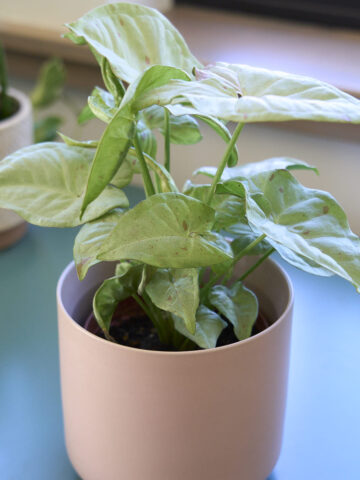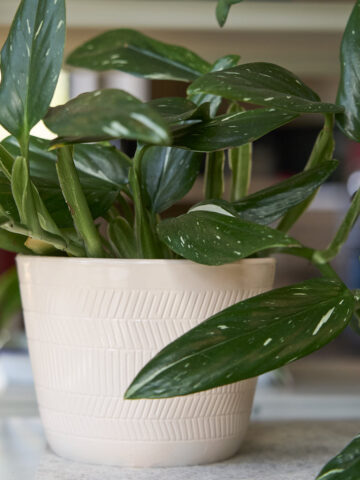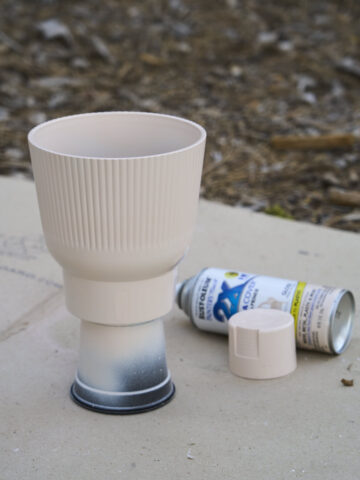Sansevieria Fernwood Mikado is fun and spunky! This snake plant adds a pop of attitude to your decor. See photos and learn how to care for this easy houseplant.

Snake plants are one of my most recommended varieties of houseplants. They can survive in nearly any room, so it's the easiest way to add greenery as decor in the home.
Fernwood is a common variety. Simple to take care of, cheap to buy, and easy to find.
Jump to:

Appearance of Mikado Fernwood
Fernwood has narrow and rolled leaves. It reminds me of 90s spiky mens hair. Take a close look. The Fernwood even has gold border and tips, like frosted hair.
The leaves grow in clumps, and mostly go straight up. As the plant matures and gets larger, it's common for the leaves to fall a bit outward, and become like an upside down broom.
Like other snake plants, the leaves are rigid so they keep their shape. It grows in a upright manner, as opposed to snake plants with a rosette growth style, like the Sansevieria Coppertone.

How to Care for Sansevieria Fernwood Mikado
It's incredibly easy to take care of a Fernwood Mikado Snake Plant. Here are three basic requirements:
- Light: Bright or medium indirect light, but it can tolerate lower light levels
- Potting Mix: Chunky
- Water: Water when the soil feels completely dry to the touch
Light Needs
Snake plants all grow best in bright indirect light, including this Fernwood Mikado. For example, place it near a large south facing window. Another good spot would be near a west facing window. Snake plants are naturally slow growing, but good light can encourage them to grow faster and healthier.
Like other snake plants, the Fernwood Mikado will also tolerate lower light levels. That's why they make such great decor pieces. I frequently rotate my snake plants around. As such, they sometimes get more natural light and other times live in a dark corner of the house.
Best Potting Mix
Like all snake plants, the Fernwood Mikado needs to have chunky soil that drains fast. You can buy a premixed snake plant soil for ease. This mix contains coco coir, perlite and dolomite.
Alternatively, I have a few of my snake plants potted in my DIY Chunky Aroid Potting Mix. I tweak the potting mix a bit to add in a bit more orchard bark and more pumice stones. The plants in this mixture have been doing great.
Water Requirements
Sansevieria Fernwood Mikado do not require frequent watering at all. The rhizomes and leaves will hold on to water. Overwatering is a major concern, as it will cause the roots to rot.
I water my snake plants when the soil is completely dry. In the summer, I might water them about every 2 weeks. Both constant airflow from open windows and a hotter home cause the potting mix to dry out faster. Plants also typically grow more in the summer months, so they use a bit more water.
In the winter, I water my Fernwood Mikado about every 3-4 weeks.
All my snake plants, including the Fernwood Mikado, enjoy being bottom watered. That means, I place the plant pot in a bowl of water for about 5 minutes, and allow the water to be absorbed from the drainage hole. The potting mix absorbs what it needs, and there's no worry about the plant sitting in excess water.

How Big Does Fernwood Mikado Get?
As you can see, my Fernwood Mikado is quite small. I started with 2 tiny plants in 2" pots. As they grew, they got too crowded and too tall for their original baby pots.
When that happened, I took a clump out from one of the 2" plants and combined it with the other plant into a 4" pot. I still have one plant in a 2" pot.
Don't let that fool you though. Fernwood Mikado can grow up to 2-3 feet tall. When the leaves get taller, they tend to arch outward a bit too, so it commands more space.
When to Repot Fernwood?
Snake Plants, including this Fernwood Mikado, like to be crowded. I tend to repot snake plants when the plastic pots become misshapen due to the roots and rhizome pushing against the pot.
As I mentioned above, my Fernwood Mikado was originally in a 2" pot. Before I repotted it, the rhizomes pushed the pot into an oval shape.
With my snake plants in bright sun, I repot them annually. For my snake plants that receive less light, I find they can go 2-3 years without the need for a larger pot.
How Do You Popogate Fernwood Mikado?
I usually propogate snake plants only when I repot. The easiest and most reliable way is to simply divide the rhizomes, and pot them into separate pots.
As snake plants grow and mature, the rhizomes spread horizontally. From the rhizomes, new shoots grow upwards into the leaves that we see. To propagate, simply remove the plant from the pot, find a good spot on the rhizome and make a clean cut. Make sure that you split the rhizomes in a spot so both parts have upright leaves.
When I last potted my Fernwood Mikado, I propagated one of the plants. The small plant that I potted back into the 2" pot is almost ready to be divided (or repotted into a larger pot) again. By dividing rhizomes to propagate the Fernwood Mikado, you can keep doing it over and over again, as soon as more rhizomes and leaves grow.

How to Style
I love my Sansevieria Fernwood Mikado in this busy patterned pot. It adds a boho charm to this plant. I think it also softens up the look a bit, because the spiky tips can look a bit aggressive.
While I have my sansevieria in a plastic pot inside this ceramic cache pot, it's good to keep in mind that these plants generally do well in terracotta pots. Terracotta pots allow for more airflow to the soil, and it allows it to dry faster to prevent any root rot.
Is Sansevieria Fernwood Mikado Rare?
Nope! Sansevieria Fernwood Mikado is a common variety that you can find in big box stores or plant nurseries.
I bought mine at Home Depot and it cost 2 for $5. However, the caveat is that these plants are often only sold in small pots.
It is rare to find a Sansevieria Fernwood Mikado being sold in 6" pots or larger. You can find larger Sansevieria Fernwood Mikados being sold online. However, they can be a bit pricey.
The good news is that since these plants are so easy to care for, once you have a baby plant, you can grow your own easily.
See More Snake Plants
As I mentioned earlier, snake plants are one of my favorite types of houseplants. There's so much to love about them, from their unique looks to the ease of care.
Here are a few other varieties that I love:




Any questions? Please ask below. And as always, I'd love to hear about your plants too.





Leave a Reply